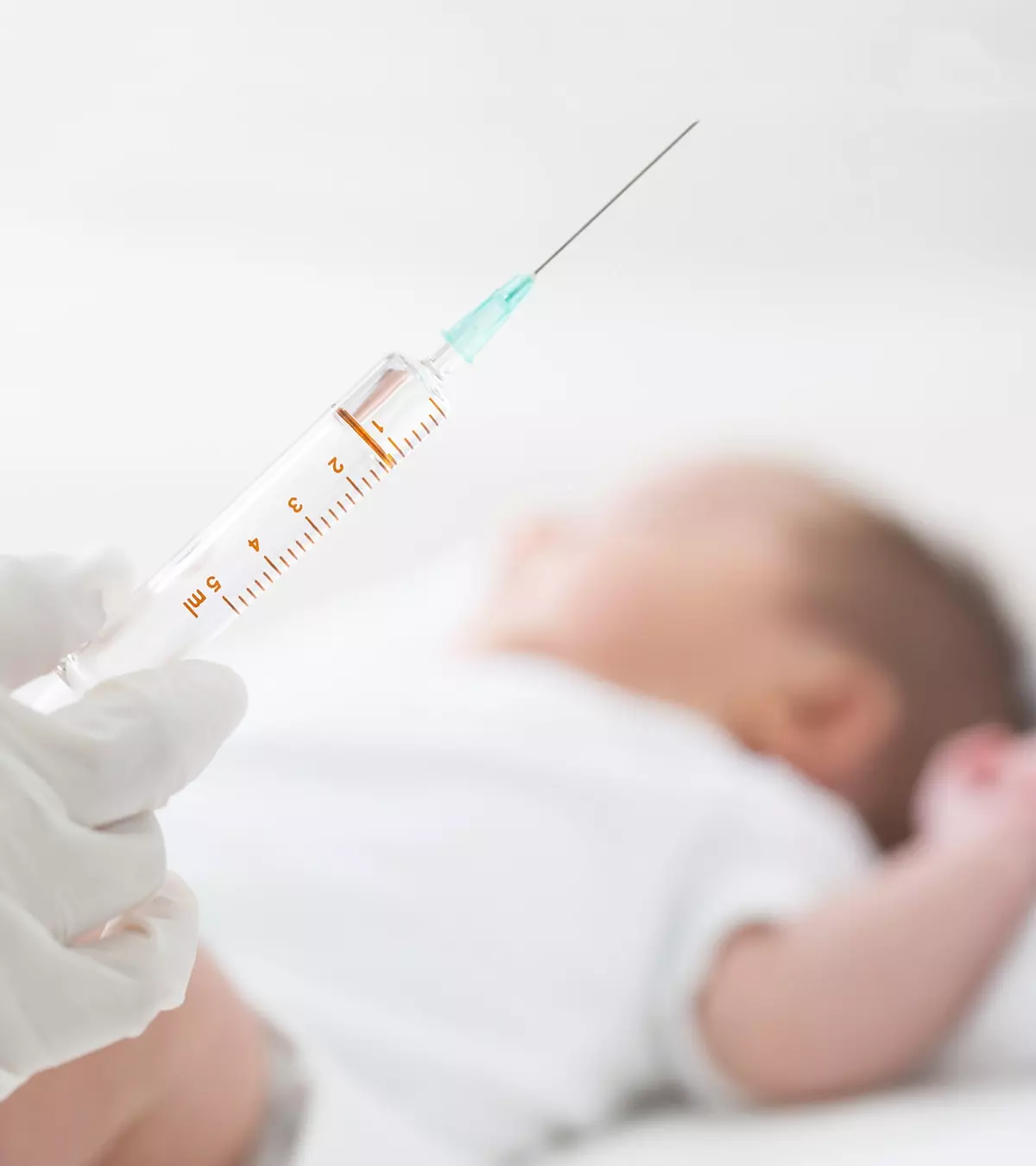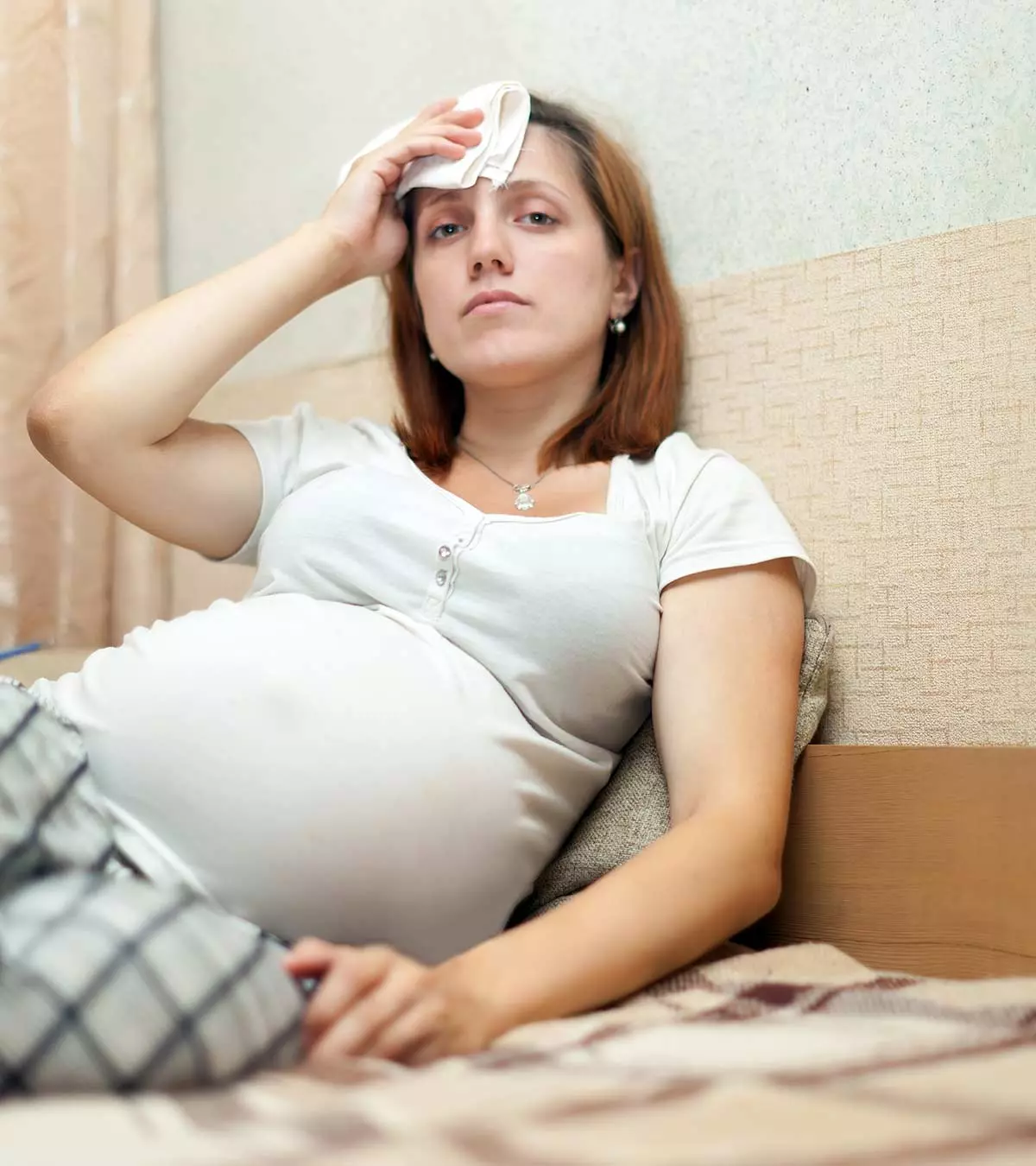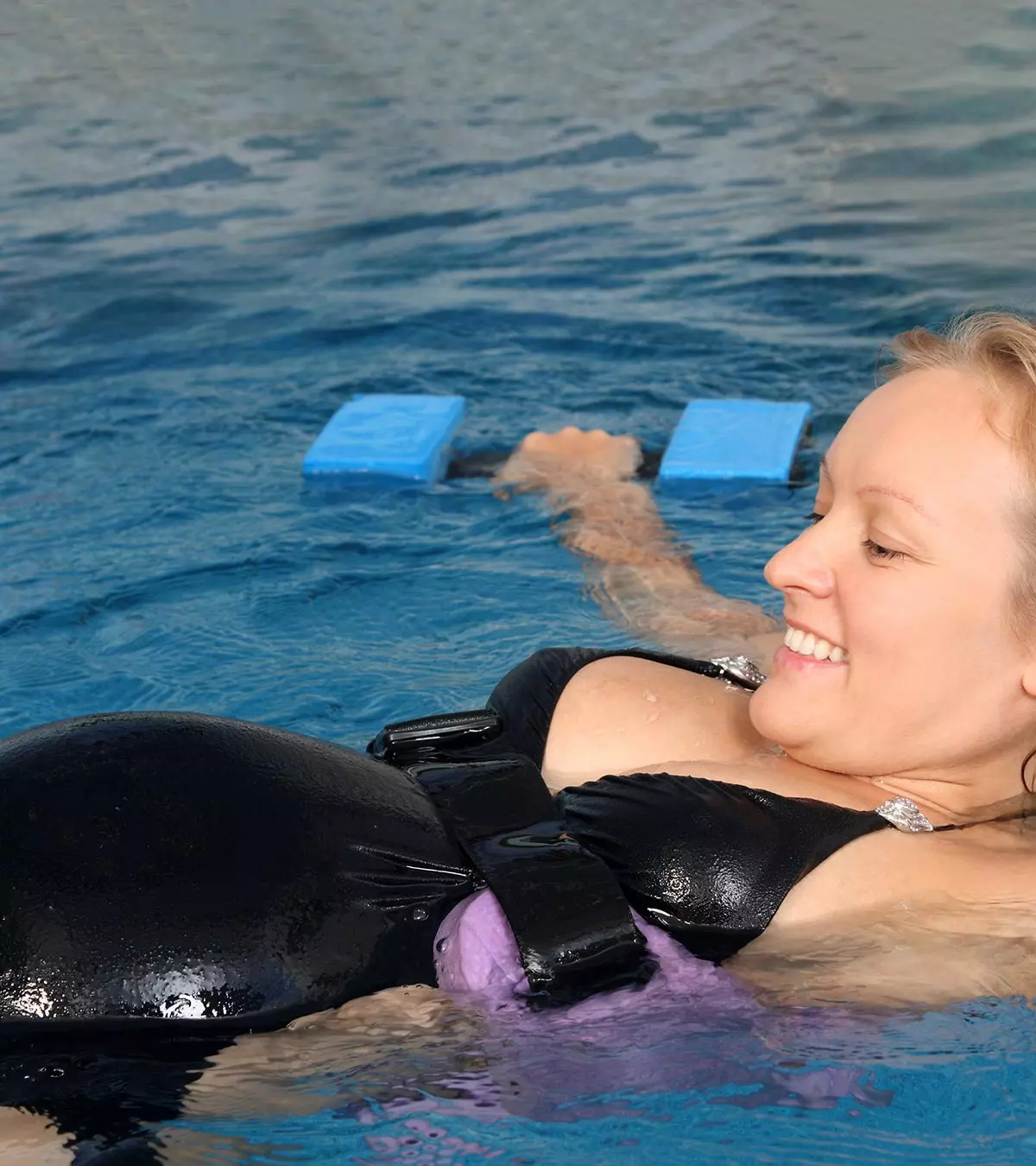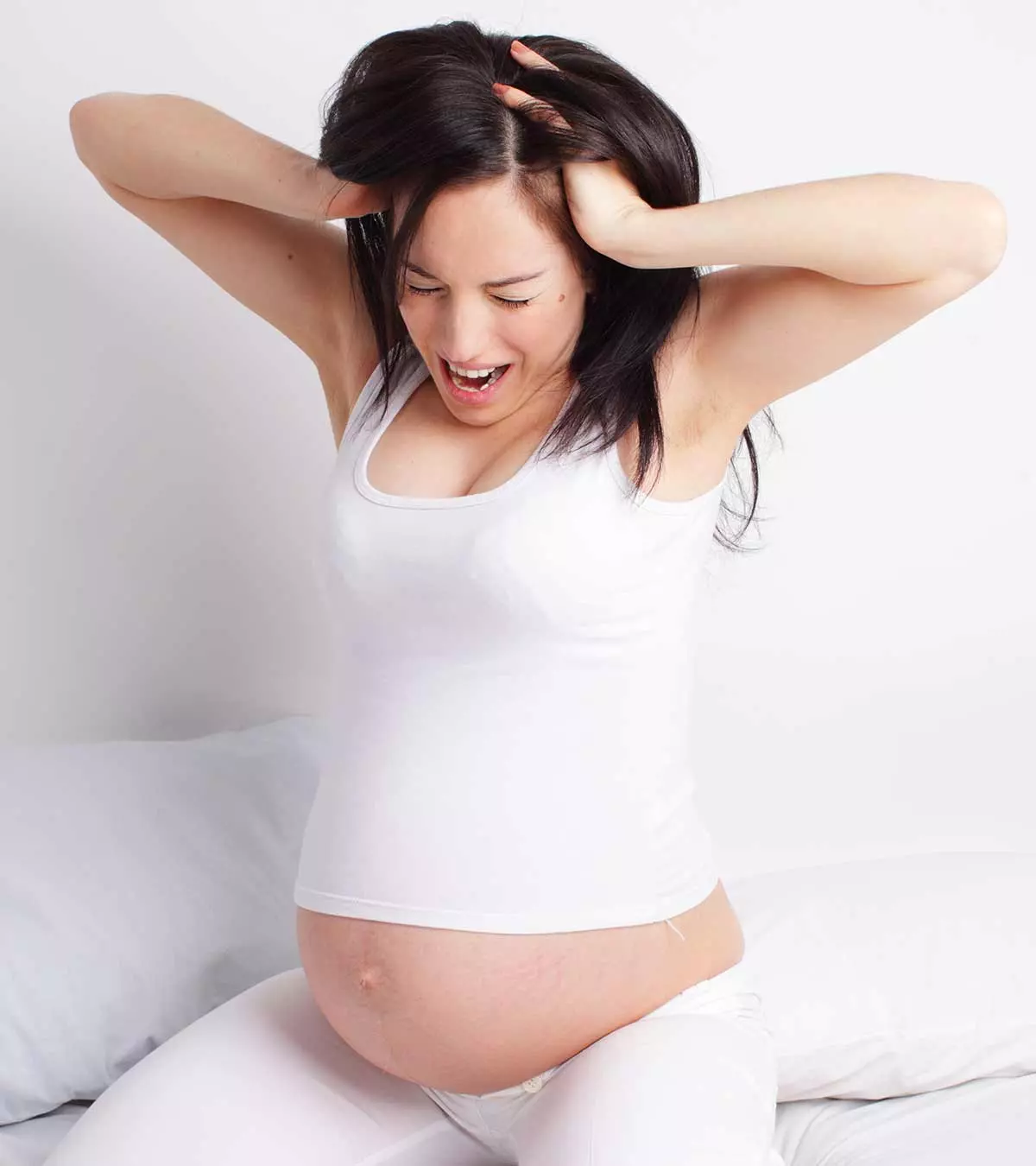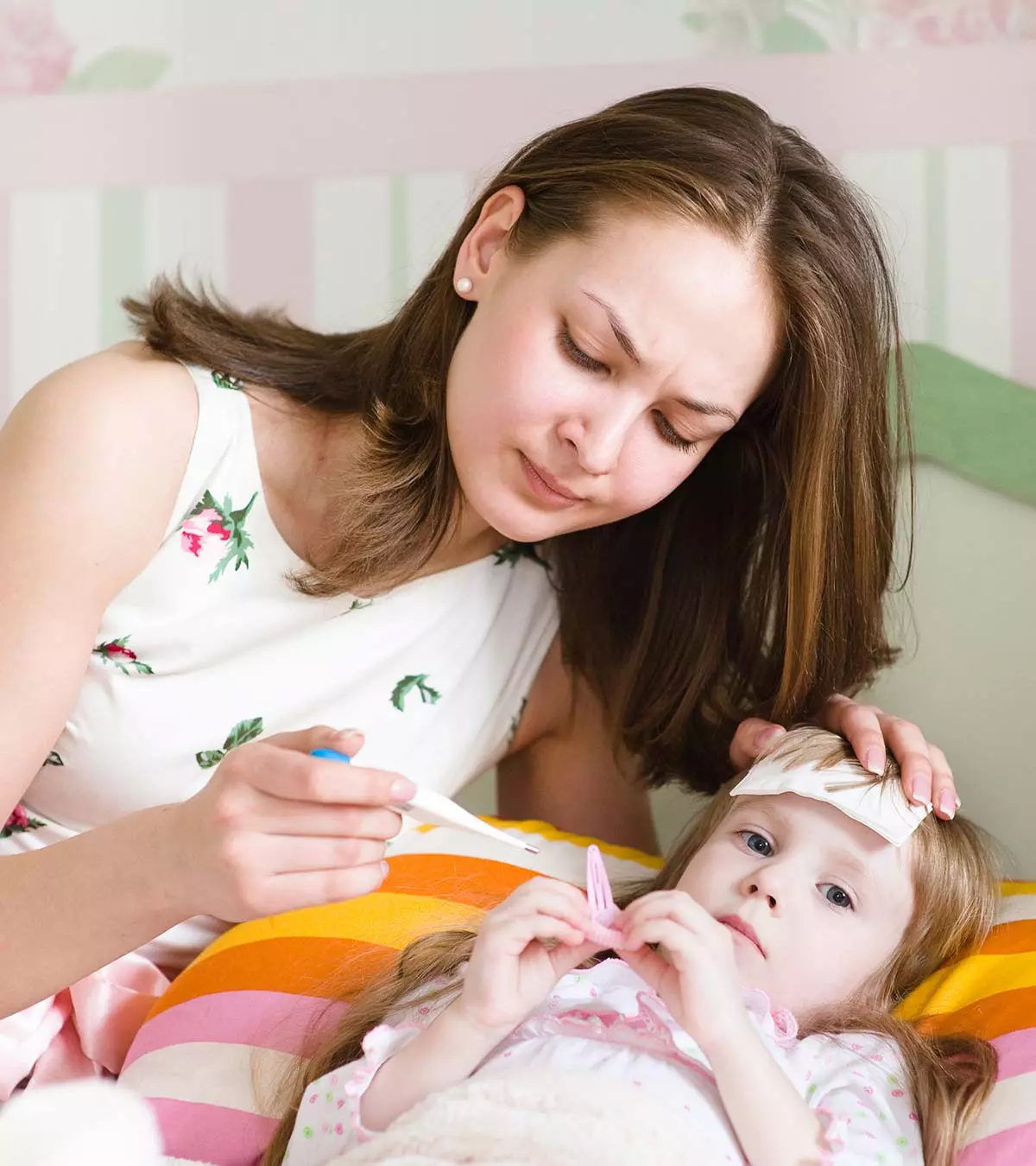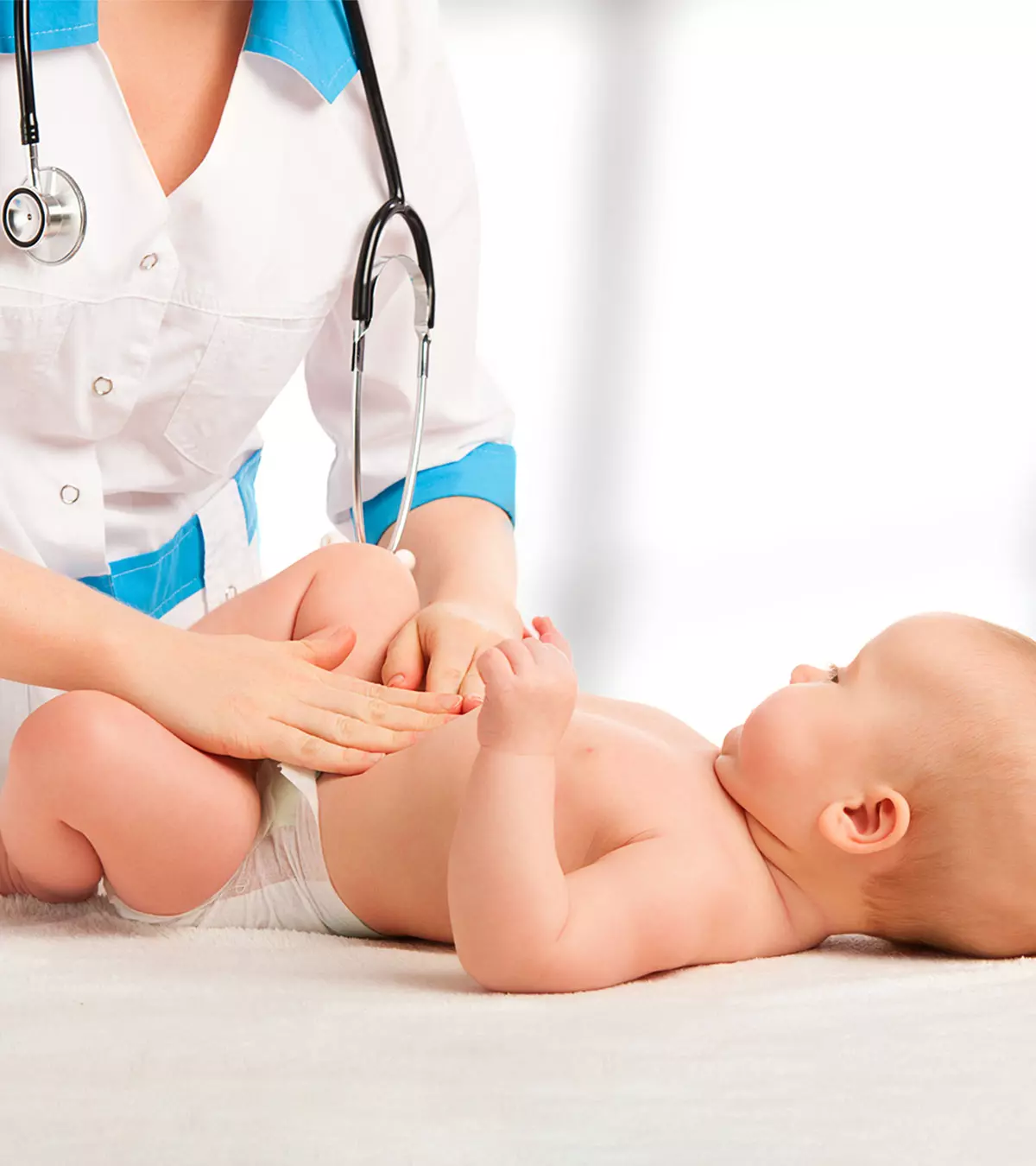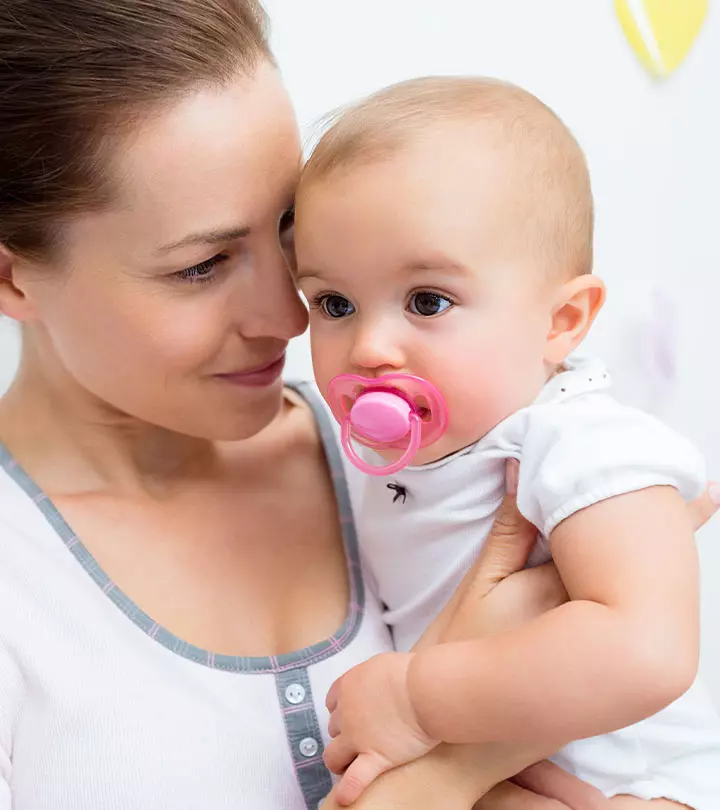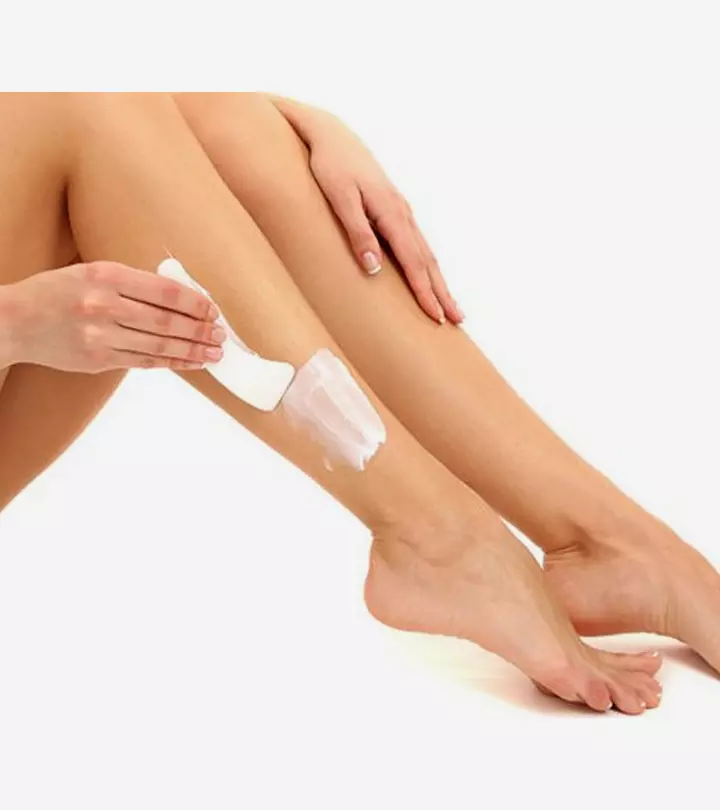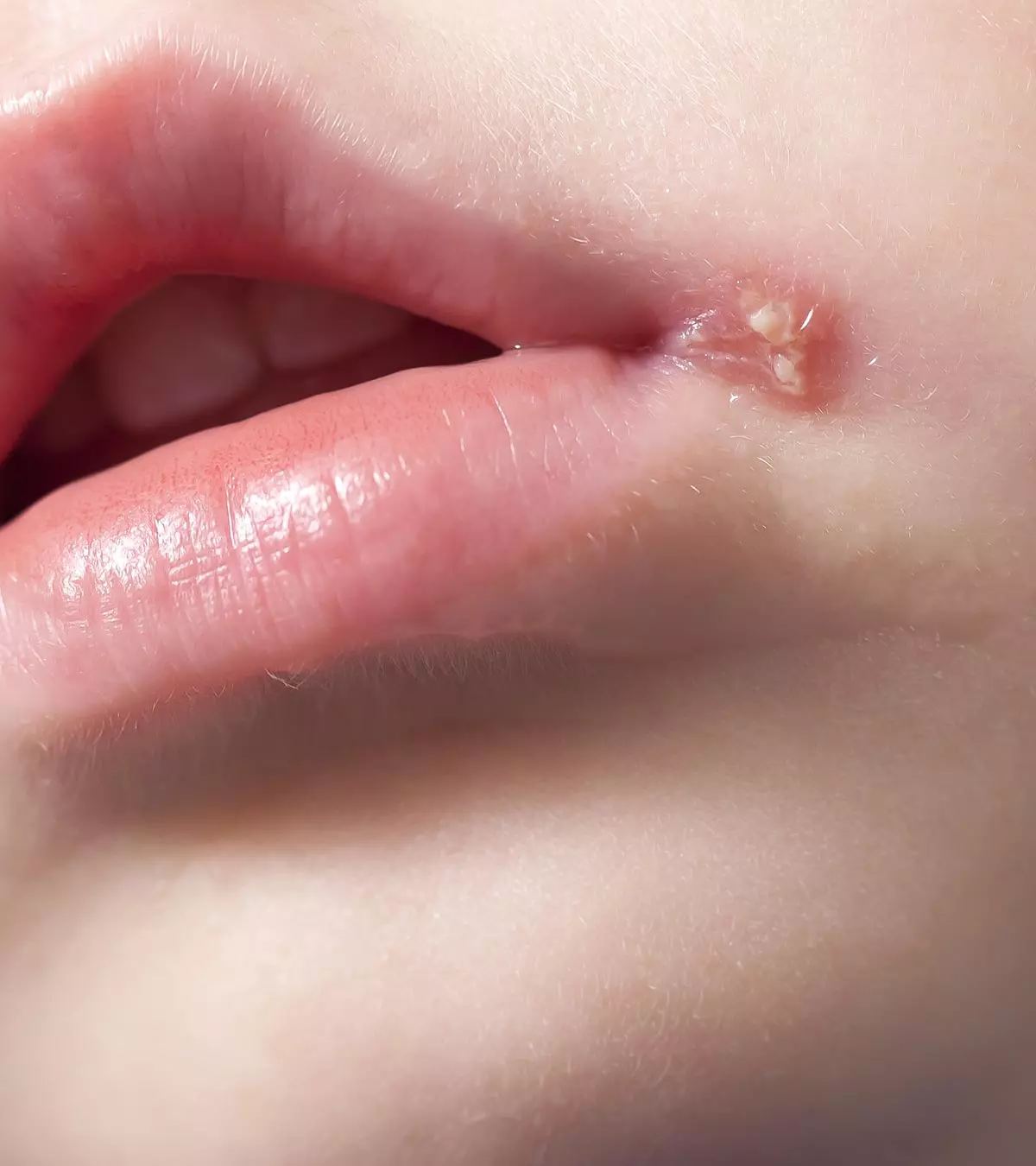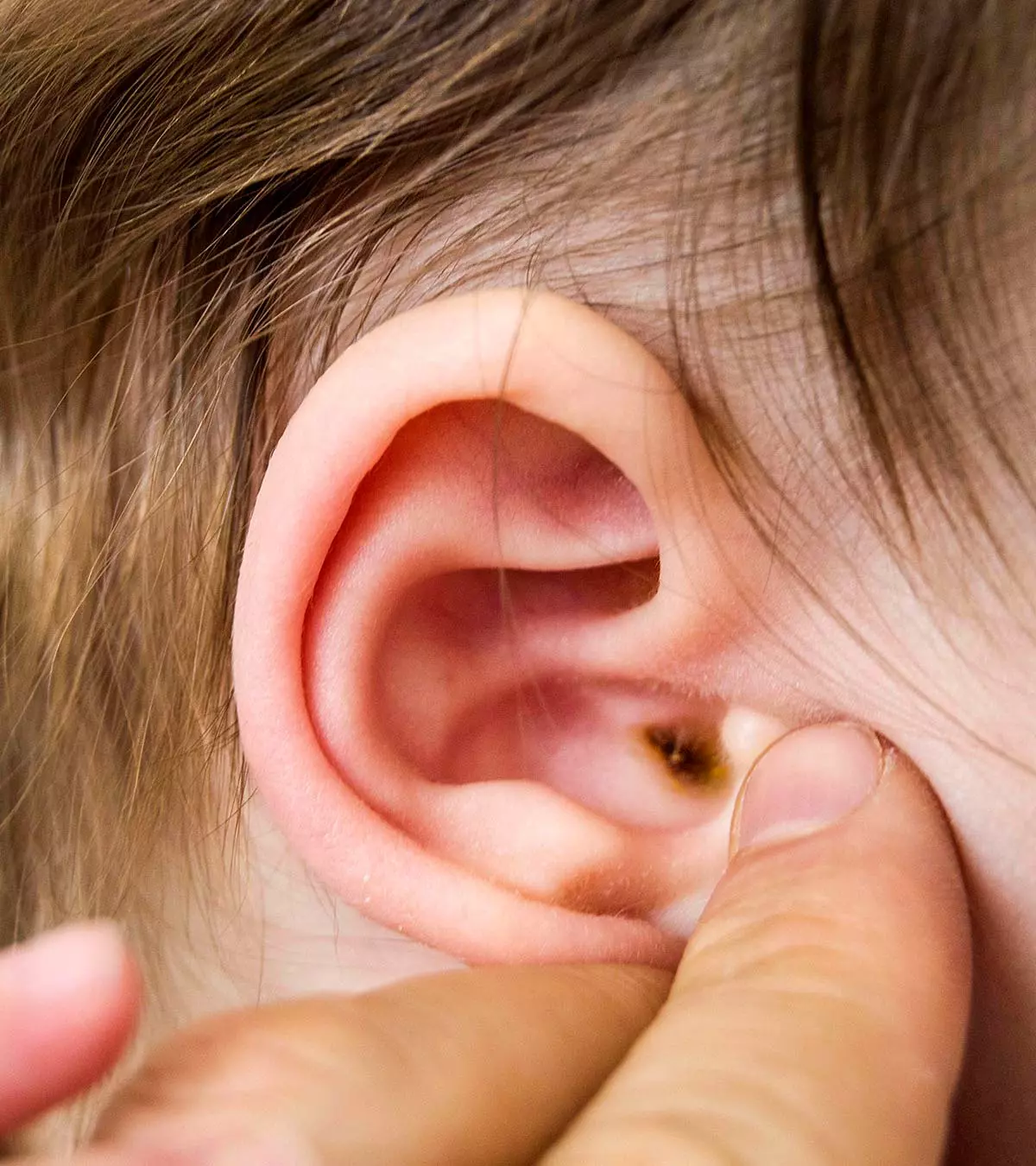
Cerumen, often called earwax, is a waxy substance naturally produced in human ears (1). New mothers may often wonder if it is necessary to and how to clean earwax in babies. Earwax is important, so removing it is not always necessary. However, thick and hardened ear wax can cause ear pain. Thus, you should consult your child’s pediatrician or pediatric ENT in such scenarios and learn when and how to safely clean your baby’s ears for their comfort and well-being. Continue reading this post as we also tell you the causes, symptoms, prevention, and treatment of earwax buildup in babies.
Key Pointers
- Cerumen, also known as earwax, is a waxy substance produced by the outer ear canals.
- The American Academy of Pediatrics recommends against cleaning a baby’s earwax at home, and only wiping the outer ear with a soft cloth.
- Babies can develop earwax due to excessive production or by cleaning the ear canal with fingers or cotton swabs.
- Hardened ear wax in the ear canal can cause itching, pain, tinnitus, and increased pressure on the eardrum.
- If a newborn exhibits signs of earwax accumulation, they should be evaluated by a doctor rather than treated at home.
Why Do Babies Have Earwax?
Earwax is naturally produced by the outer ear canal, which lies between the earlobe and the eardrum of the middle ear (2). It may seem like an unnecessary biological waste but has its uses, such as these (3):
- Waterproofs the ear canal
- Acts as a sticky trap for dust and insects
- Lubricates the ear canal to prevent irritation
- Ear wax is made of compounds that have antibacterial and antifungal properties
- Ear wax is produced only in the outer ⅔ of the ear canal
 Quick fact
Quick factA common question parents have about baby hygiene is how to safely clean their baby’s earwax. Should you leave it alone or remove it?
Should You Clean Baby’s Ear Wax Regularly?
The American Academy of Pediatrics recommends not to clean a baby’s earwax at home using a cotton bud or ear drops (4). Doctors, too, recommend that if earwax does not cause pain or block the ear canal, it should be left alone.
You must only clean the outer ear using a soft cloth soaked in warm water. Run the cloth around the rims of the external ear and avoid ear cleaning solutions or techniques such as ear flushing, pouring hydrogen peroxide, mineral oil, etc., into the ear canal. It might complicate the condition. If the earwax is too well lodged, you may bathe your baby in warm water. The steam may help loosen the wax, which may then easily be removed with a washcloth (17).
However, sometimes there could be excessive earwax production in babies that might lead to earwax blockage of the ear canal, causing pain.
What Causes Earwax Buildup In Babies?
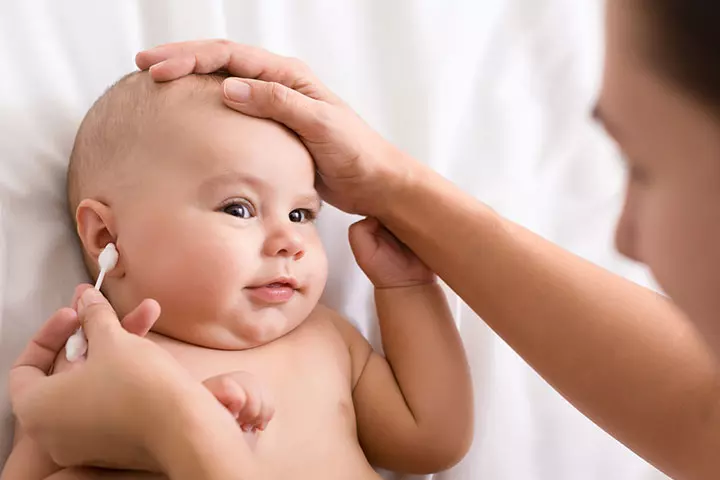
There is no single reason for earwax buildup in infants. The following, however, are a few common causes of earwax complications among infants (5):
- Excess earwax secretion: In about 5% of children, there is excess earwax secretion, which can cause more wax accumulation than usual.
- Pushing objects into the ear canal: Putting objects in the baby’s ear canal pushes the earwax deeper.
- Repeated insertion of finger into ear canal: A baby’s ear canal is narrow and small. Putting a finger inside it frequently could pack the earwax within. Therefore, never use your finger to clean the baby’s ear and discourage the infant from sticking their finger into the ear.
- Extended use of hearing aids or earplugs: In 2019, data from the Centers for Disease Control and Prevention revealed a prevalence of 1.7 cases of hearing loss per 1,000 babies screened. For the treatment of this condition, hearing aids offer an effective solution, enhancing both hearing and speech abilities. However, hearing aids and earplugs block the entrance of the ear canal, which prevents the wax from shedding. If your baby wears a hearing aid or earplugs for several hours a day, they could be at risk of developing hardened ear wax.
- Use of cotton swabs: Cotton swabs, also called cotton buds, cotton tips, or Q-tips, are not ideal for removing earwax, and medical experts recommend against its use. A cotton bud can push the earwax deep into the ear canal, causing it to get stuck and cause irritation to the ear canal itself.
 Quick fact
Quick factEarwax secretion may seem like a trivial thing, but it could cause discomfort and pain to infants and toddlers, who may then display certain symptoms.
What Are The Symptoms Of Excess Earwax Buildup In Babies?

The following are some common symptoms of earwax accumulation in a baby’s ear (6).
- Older infants and toddlers may point at their ears to indicate that something is wrong with it. Ear wax can harden and cause the sensation of something being stuck within the ear canal.
- Earwax impaction can obstruct the ear canal, causing hearing difficulties.
- If the earwax accumulation is very severe, you may even see a bit of hardened wax sticking out from the ear canal of the baby.
- Severe symptoms of earwax accumulation include pain, fussiness, and sometimes even dizziness.
 Be watchful
Be watchfulTake your baby to a doctor if any of these symptoms are evident. Excess hardened earwax can increase pressure on the eardrum, causing further complications.
Can Earwax Cause Problems In Babies?
Yes, but only when it gets hard and impacted. Ear wax gradually moves to the opening of the ear and sheds itself in small quantities. In some cases, hardened earwax that lodges too deep into the ear canal can create problems for the infant. These problems could be (18):
- Itching
- Ear pain
- Poor hearing
- TinnitusiThe perception of a ringing, roaring, hissing, or buzzing sound in the ear when there is no external source
Prompt removal of excessive earwax from the baby’s ear is essential to avoid these problems. However, it must be performed by a medical or nursing specialist who has been trained appropriately for it.
How Is Excess Earwax In Babies Removed?
In cases where excessive earwax is causing issues, a doctor will use the following methods to get rid of excess wax (18).
- Ear drops: Pediatric otolaryngologist Nandini Govil says, “Use an eye dropper you can get at the pharmacy, put a couple of drops in the ears once a day for about a week. It helps soften the earwax; however, it doesn’t get rid of the earwax (17).” The number of drops and the duration of treatment depends on the extent of the earwax accumulation. You will need to make the baby lie down, turn the affected ear upwards, and pour the drops into the canal, then press the little skin flap in front of the ear so that the ear drops go into the ear canal. It is advised not to use ear wax candles for removing ear wax as it might harm the baby.
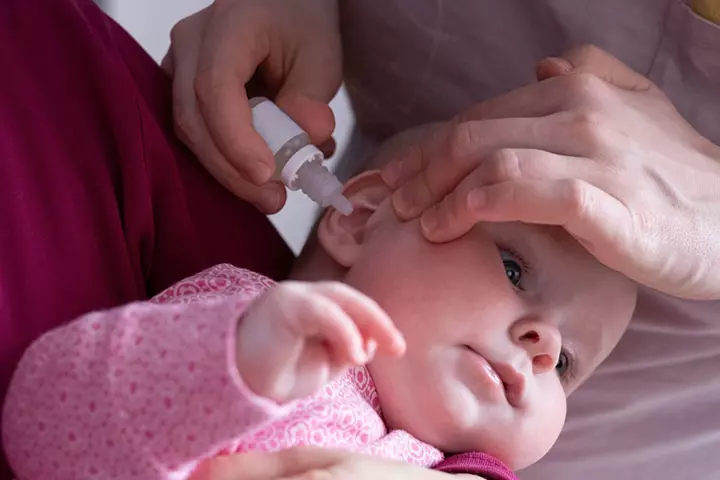
Hold the baby in the lying position for a few minutes before letting them sit up. Loosened earwax will come out on its own and should not be prodded using a finger or cotton bud. Earwax-softening drops are available over the counter too, but one must never use them for babies unless prescribed or advised by the doctor. The American Academy of Pediatrics advises parents to only use products that are FDA-approved (7).
- Ear irrigation: Ear irrigation or syringing is a medical procedure of earwax removal in which warm water is squirted into the baby’s ear. It helps weaken and dislodge the wax from the ear with water, baby oil, or saline solution, which works as an ear wax softener (8). You can also use a bulb ear syringe if this doesn’t work.
- Microsuction: A small suction tube (“hoover”) or ear wax vacuum is used to suck the ear wax out of the ear canal under the use of a good light source and magnification.
- Manual earwax removal may be necessary if the earwax is stubbornly hard. Ear, Nose, Throat (ENT) doctors have a specialized set of tools to safely extract the earwax manually with the help of an ear wax remover. The child has to be still for the procedure, so a parent will have to hold the baby. Very rarely, when the infant is unable to lie still, or if the earwax is very hard to cause pain during extraction, the doctor may consider using general anesthesia to the baby.
In case the baby already had an infection within the ear canal, the doctor may prescribe an antibiotic after the earwax removal procedure.
How To Prevent Earwax Problems In Babies?
Bathing is enough to loosen the wax and get it out.
However, some safe cleaning methods for ear hygiene can help prevent earwax problems in babies (1). Here are some of them:
- Never use cotton swabs: Cotton swabs are widely discouraged for use by medical professionals because they push the earwax deeper into the ear canal. Since the ear canal has a self-cleaning property, there is no need to remove the earwax manually. Also, the wax serves a purpose and is not the body’s waste product.
- Do not try removing earwax with a finger or object: If you see earwax accumulated inside your baby’s ear, then do not try picking it out. You may cause the wax to slide deeper while also increasing the risk of eardrum injury. Also, avoid ear candlingiA conical device where one end is inserted into the ear canal, and the other is set on fire to generate a vacuum and extract the ear wax as it can raise the risk of damaging the ear drum and canal by either causing a burn or punching a hole (18).
- Remove hearing aids when the baby is asleep: If your baby wears hearing aids, then take them off when asleep or other intervals as discussed with the audiologists. It will allow the shedding of earwax and prevent accumulation. Sometimes it is necessary to use some softening ear drops every night when the hearing aids are not used to support the process.Limit the earplug usage, if you’ve been using them for the baby for some reason.

- Check ears: You may want to check your baby’s ears every time after a bath. It allows you to notice any early accumulation of earwax inside the ear canal but if you see the ear wax coming out by itself, it should be a good sign that they are self- cleaning. These observations are even more essential when the baby wears hearing aids. Dry any water accumulating in the baby’s outer ear with a dry washcloth or using a hair dryer. The dryer must be held ten inches from the ear and kept on the lowest and coolest settings. It may help remove moisture and excess earwax without hurting the baby (17).
Taking the baby to the doctor for a checkup can also help identify if the problem is due to earwax or an infection.
How To Differentiate Between Earwax Buildup And Ear Infection?
A baby with an ear infection might display symptoms similar to that of earwax accumulation. However, ear infections in babies can cause other symptoms such as fever, fluid discharge from the ear, earache, poor appetite, and unexplained crying with fussiness (9) (10). The earwax is also smelly in the case of an infection.
Check the ear canal for yellowish-brown spots, which is the natural color of wax. If you notice redness, dampness, yellowish or green discharge, then it is quite likely to be an ear infection.
Frequently Asked Questions
1. Does earwax fall out on its own?
Yes, old earwax typically falls out on its own as it moves through the ear canal with the help of jaw motions, such as chewing (11).
2. How should I get rid of ear wax chunks in my baby’s ear?
If the earwax chunks are not blocking the ear, you may try some simple home remedies. Put two to three drops of almond or medical-grade olive oil three to four times a day. Doing this for three to five days will ensure the chunks of earwax will loosen and fall out while lying down (12).
3. Can I put breast milk in my baby’s ear?
No, breastmilk should not be put inside the baby’s ears, especially into the middle ear or the eustachian tube, as it increases the risk for infection (14) (15).
4. What should I do if I accidentally push earwax deeper into my baby’s ear canal?
If you accidentally push the earwax deep into your baby’s ear canal, do not try to flush out the wax through ear drops, water, or solution if your baby is under six years. Consult your pediatrician to carry out the process safely (16).
5. What are some safety guidelines for cleaning my baby’s ears?
When cleaning a baby’s ears, prioritize safety by avoiding cotton swabs or pointed objects. Instead, use warm water and a soft cloth to clean the outer ear. Also, do not attempt to remove earwax yourself if your baby shows signs of pain or discomfort, as it may indicate an underlying issue. If you’re uncertain about the cleaning process or notice anything unusual, consult a pediatrician.
Most parents wonder how to clean baby earwax; however, they should understand that earwax is important for ears’ lubrication, prevention of infection, and many other vital functions. Therefore, it is suggested that earwax should not be cleaned. If the wax becomes hard and painful, you should consult a doctor rather than clean it at home. The common reasons for earwax buildup in babies may be excess wax secretion or repeated finger insertion. Some symptoms that may help you understand this condition are hearing difficulties, pain, and fussiness. Be watchful of your baby’s ear discomfort and consult a doctor if there are any issues.
Infographic: Consequences Of Using Cotton Buds To Clear Baby’s Ear
It is soft and convenient, so why not use a cotton bud or swab to clean a baby’s ear? If you think so, check out this infographic to understand why it is not safe to use a cotton bud for cleaning your infant’s ear and what could be the adverse effects of using one. Illustration: Momjunction Design Team
Illustration: How To Clean Baby Earwax? Effective Tips And Home Remedies

Image: Dalle E/MomJunction Design Team
Learn safe and easy ways to remove earwax and relieve your child’s ear blockage. Follow clear and precise instructions to enhance your child’s comfort and overall health.
References
1. How and When to Clean Your Child’s Ears; Children’s Hospital, Los Angeles
2. Ear Wax Buildup & Blockage; Cleveland Clinic
3. Does Earwax Serve A Purpose?; Jamaica Hospital Medical Center
4. Earwax Buildup; American Academy of Pediatrics
5. Earwax Buildup; Seattle Children’s Hospital
6. Earwax Buildup; Healthy Children; American Academy of Pediatrics
7. Check ingredients before using prescription ear drops on children; American Academy of Pediatrics
8. Earwax build-up and removal; Health Navigator, New Zealand
9. Ear – Pulling At or Rubbing; Healthy Children; American Academy of Pediatrics
10. Otitis Media (Middle Ear Infection); Children’s Hospital of Philadelphia
11. Earwax build-up; NHS
12. Earwax; Nationwide Children’s
13. Microtia and anotia; March Of Dimes
14. Ear Infections in Babies and Toddlers; John Hopkins Medicine
15. Ear infections; NCBI
16. Earwax Buildup; Seattle Children’s
17. How to Safely Clean Your Child’s Ears; Children’s Healthcare of Atlanta
18. Dealing With Earwax (Cerumen); The Nemours Foundation
Community Experiences
Join the conversation and become a part of our nurturing community! Share your stories, experiences, and insights to connect with fellow parents.
Read full bio of Dr. Sebastian Hendricks
Read full bio of Rohit Garoo
Read full bio of Dr. Ritika Shah
Read full bio of Ghazia Shah





